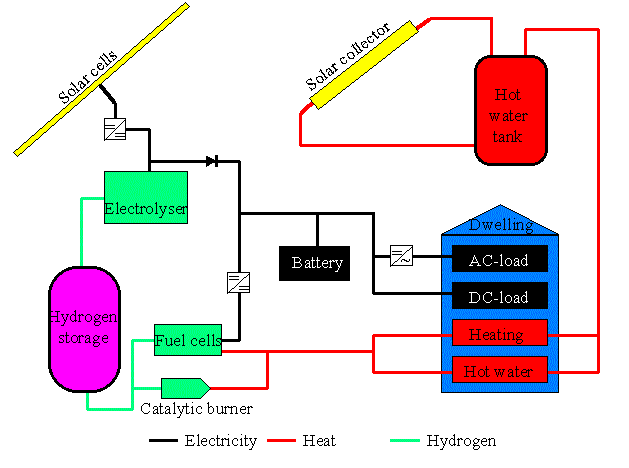 PV-Hydrogen
System Simulator
PV-Hydrogen
System Simulator
 PV-Hydrogen
System Simulator
PV-Hydrogen
System Simulator

Schematic of solar hydrogen system
Table of Contents:
PVHYDRO simulates a photovoltaic system with hydrogen as storage medium. The photovoltaic hydrogen system has a photovoltaic array with an optional maximum power point tracker that supplies electrical energy to the system. This electrical energy supplies the current energy demand, the battery or the electrolyzer with energy. The first priority is the energy demand. If there is more energy supplied than needed, the battery will be charged to a certain level. After the battery reaches this level, the electrolyzer will be turned on, and the hydrogen produced will be stored in a pressurized tank until needed (winter). The hydrogen will when the solar system does not supply enough energy, be burned in a fuel cell (with a converter) to produce electrical energy or optionally burned in a catalytic burner for heat. In addition, a solar thermal system gives heat to cover some of the hot water heating demand. The load is modeled from a low energy dwelling and will vary depending on what location is chosen for the simulation.
PVHYDRO 1.0 uses TRNSYS which is a quasi-steady performance simulation tool. It calculates the state of each component every time step. TRNSYS is an ideal software for the modeling of systems composed of several interconnected components because TRNSYS itself is composed of linked modules. The components used in the PVHYDRO are:
Most of the PV and hydrogen models originated from Frauenhofer Institute in Freiburg. Their models have been further developed and improved at the Norwegian Institute of Technology in collaboration with the Solar Energy Laboratory. The present work to improve the models and make them available to other users is done at the Solar Energy Laboratory and sponsored by the Norwegian Research Institute.
The user can select the number of cells in parallel or series. The program simulates the current flow of the system thus enabling the user to eliminate the maximum power point tracker (MPPT) and thereby simplifying the system. If the MPPT is eliminated, the user should pay close attention to the matching of the voltage for the battery, photovoltaic cells and electrolyzer in the system because this will be an important factor for the performance of the system.
The system always assumes that heat produced from either the solar collector or the fuel cell has the first priority to be used. If this is not enough to cover the heating loads, what is left of the heating loads are covered either by burning hydrogen or by electricity.
PVHYDRO 1.0 provides a configurable user interface, running under TRNSED. The user can specify the simulation end (the starting time of the simulation is January 1.), the time step as well as weather profiles. Time steps from 0.01 to 1 hour are permitted. Pop up menus are provided. The user selects a number of data sizing the components and loads for the desired system. The system has an online plotter that plots some of the central variables. The plots of the individual variables can be turned off and on by clicking on the labels for the desired variable thus making it easier to see the desired plots. The user can also stop the simulation (or wait till the end of the simulation) and zoom in on areas of particular interest.
After selecting "Calculate" from the TRNSYS main menu item, PVHYDRO presents an on-screen plot as the simulation progresses. The plot shows the some of the energy outputs from the system as well as the state of charge of the battery and hydrogen storage. The load that could not be covered by the system will also be displayed in the online plot.
The outputs are mainly of the energy outputs of the components. The simulations can easily be changed to output the efficiencies, the voltage, the temperatures, the current etc. of the components. This is not included in the demonstration program due to the enormous amount of possible outputs. This could however easily be added into or changed in the program.
When the simulation is done, the user can view the outputs, listing or make a plot of the selected outputs. The outputs is the summary of the energy outputs over the simulation period. The plots will be similar to the online plotter but will include some more outputs. The plots will be possible to save and configured to meet the users preferences.
Downloading, Installing, and Running the Demonstration Program
The demonstration executable file is a 32-bit self-extracting, self-installing file called pvhydro.exe.
Click to download pvhydro.exe.
Follow the instructions for installing the demonstration and launch TRNSED. From TRNSED, open the demonstration file. Select 'Calculate' from the 'TRNSYS' menu of TRNSED. The online plot of the progress of the simulation will indicate a successful simulation.
To run this demonstration you must have an IBM compatible computer (486 or higher), running Windows 95 or NT, a VGA monitor or SVGA monitor and about 5 MB of free disk space.
Comments or suggestions for improvements about the PVHYDRO demonstration program are appreciated. If you have any questions or wish to speak to someone about the PV-hydrogen simulations, please contact: